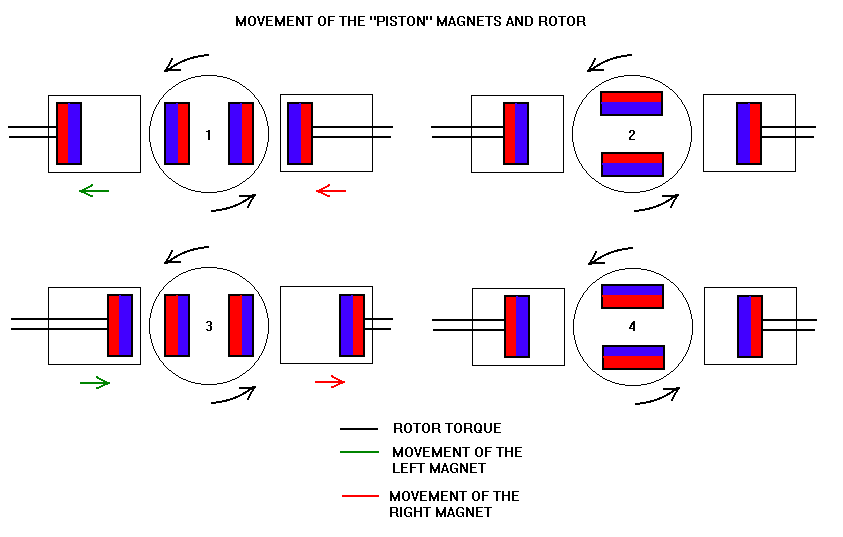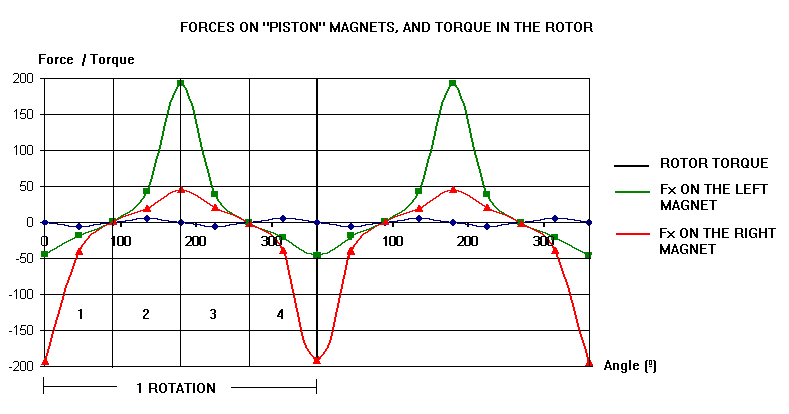
Take a look to the following system:

In terms of torque, the rotor sees (almost) no opposition to
turn, but in terms of forces on the sliding "piston"
magnets, they feels (almost) the same force the rotor will
produce without the other side.
We only have to apply little torque.
Also, I think the forces on sliding magnets could be optimized.

The
opposition forces and the attraction forces are not the same, so
they don't completely annul, but the torque is reduced in a big
quantity.
I think the forces obtained on the piston magnets can be (maybe
not all the force, maybe not all the time, but...) properly used
to get more power than the power needed to make the rotor magnets
turn.
I will explain what i think is happening:
As Alexander said to me a long time ago; every action has a
reaction, but this two equal, opposite and "same time"
forces take place on different objects.
If you launch a rocket to the space, you're pushing the earth
apart in the same force amount.
Look to the left side of the "magnetic" machine. As you
move the rotor, the sliding magnet feels attraction or repulsion
(action), so a force is needed or exerted on the rotor to
turn(reaction). Now, look at the other side. In fact you've got
the opposite action been exerted on ANOTHER sliding magnet, so
the reaction in the SAME rotor is the opposite than on the other
side.
You've got two actions been done (on different objects), and no
reaction (or reaction cancelling) in the same rotor!
It's like launch two rockets from opposite sides of the earth,
the reaction forces on earth cancels, and the earth feels no
effect.
To the rotor, it's like if the torque due to one sliding magnet
were "phase cancelled" with the torque of the other
side, so (almost) no torque has to be exerted, but the effect on
the sliding magnets takes place.
The sequence now is:
Action: you turn the rotor (almost) freely, and...
Reaction: You obtain two "phase" opposed forces on two
sliding magnets. This forces can be used as if you were exerting
a real torque into the rotor, so the power extracted from the
sliding magnets can be greater than the needed to turn the rotor.
This is better explained on a web page i've found:
"...Cause and Two Contra-directional Effects for Spatial
Separation
Simple example for two spatially separated effects are operating.
It is closed in loop ferromagnetic core and two coils L1 and L2.
Let's assume that primary flux is increasing. Direction of
secondary induced flux B1 in area of coil L2 is co-directional to
primary flux. Also direction of secondary induced flux B2 in area
of coil L1 is co-directional to primary flux. So, secondary
fluxes are contra-directional to each other.
If primary flux is not increasing but decreasing the situation is
the same. So, from the primary source point of view the secondary
fluxes are mutual-compensated. It means that two power sources L1
and L2 are working without any power consumption.
Demonstration system for the conference included several
permanent magnets are placed inside of disk plastic rotor, that
is rotating by small electromotor. In experiments it was
demonstrated that power in load of L1 is increasing when coil L2
is connected.
So, when two contra-directional effects are working for each
other there is no needs in any input power. Rotor is not
decelerating if the load is connected to generator coils. The
role of changing primary flux source is information source only
and it is not the power source. It is possible to build the free
power generator that have efficiency more 100% since the back
torque effect is equal to zero for this bi-directional load
version."
I have made the comparison of the torque of an attracted rotary
magnet, and the same magnet when it has two stator north poles at
the sides, like this:
........S.......
........N........
..................
.......SN...... (With only air)
..................
........S........
........N........
And:
........S........
........N........
..................
SN...SN...NS (with two north poles, it can be south poles also)
..................
........S........
........N........
The results of the simulations show that the torque is (almost)
the same:
ang...... torque air.....torque magnets
0.............. -1,424....…...-1,437
20............ -1,732...…....-1,318
40............ -3,16.....…....-2,579
60............ -4,886..….....-4,644
80............ -2,760..….....-2,689
I can imagine
thousands of ways to get a 360º rotating magnet without spending
(almost) work. A current can manage the poles surrounding the
rotary magnet to get no effects from the cores in the rotor(zero
torque), nor from the rotor in the coils (back EMF cancelling),
so we can have the rotary magnet always been attracted on a
closed loop, with (almost) no back EMF on the coils that
"hides" the surrounding poles when needed. If the
current stops, the magnetization changes again, and the
attraction comes again.
I spoke about something similar on another topic, but no one
(maybe HLAFORD) understood what I was talking about.
It was called Iron-magnet attraction to get free work on a
rotor
The simulation says it's possible.
It's possible annul an E-M wave by superposing an "inverted
phase" one, and it's possible annul sound (a mechanical
wave) by emitting "inverted phase" waves. I'm talking
about annul mechanical or electrical reactions without annulling
the actions attached, just "exciting" the
"annulled forces" element to get the actions on other
elements (moving the rotor with little torque needed, or making
an electric current run through coils with little back EMF).
Normally, with a rotary magnet and a stator magnet, there are two
semi-cycles on a loop:
1 - the potential energy (PE) of the rotary magnet transforms
into kinetic energy (KE), and the stator magnet PE increase.
2 - Now, we have to apply more energy to transform the kinetic
energy (KE) of the rotary magnet again into potential energy
(PE), and to put the rotary magnet in the initial situation. The
stator magnet PE decrease to the initial PE also.
In this cycle, you've to apply the energy amount to convert KE
into PE on rotary magnet.
So the work extracted is the same than the work we have to do.
But now think about the rotor with zero torque:
In this device, the conversion of PE into KE of one rotor magnet
is used to transform the KE into PE on the other rotor magnet, so
finally, in the rotor we have only PE to PE modulations or
transfers from one rotor magnet to another. We have not to apply
any external work to do that, only the turning of the rotor does
that.
1 - One rotor magnet pass from PE to KE, the other from KE to PE,
so no work exerted (the rotor magnets helps each other to make
the transformations). BUT the stator magnets change also their
potential energy. One increase the PE and the other decrease it.
2 - Now, one rotor magnet pass from KE to PE and the other from
PE to KE, so no external work is needed, but the stator magnets
change PE, one decrease PE and the other increase it.
I think actually the rotor magnets don't transform PE into KE (so
later, you have not to apply work to transform KE into PE) the KE
in the rotor is constant as you turn the rotor without work. The
rotor magnets changes it's PE one to each other, and the stator
magnets change its PE to compensate this variations. (That's what
I think)
You're "modulating" the PE variations on the stator
magnets with the KE you apply to the rotor, that's why HLAFORD
called it a kind of "mechanical" transistor.